
Page Contents
- 1 What causes osteochondrosis of the lumbosacral spine?
- 2 How does the pathology develop?
- 3 Symptoms and stages of osteochondrosis
- 4 Methods of treatment
Osteochondrosis of lumbosacral spine is a serious disease of the musculoskeletal system, characterized by deformation and dystrophic changes of the intervertebral discs. This is a fairly common problem. According to statistics, up to 80% of patients seeking medical help with complaints of back pain suffer from osteochondrosis. Pathological changes in the spine are dangerous because they eventually lead to the appearance of hernias and complicated disc protrusions. This process is accompanied by a constant pain syndrome, which most negatively affects the health and significantly reduces the patient's quality.
Persons at risk of over 35 years of age who have a passive lifestyle, in particular, engaged in office work. In addition, the frequency of the disease increases with age and problems with the spine are harassed by men and women older than 50 years. What triggers the development of the disease, which symptoms should alert and become a reason for seeking medical help? The answers to these questions can be found in our article.
What causes osteochondrosis of the lumbosacral spine?
 Deforming osteochondrosis of the lumbosacral spine of can provoke many causes:
Deforming osteochondrosis of the lumbosacral spine of can provoke many causes:
- Constant elevated loads. This factor is the main one for people engaged in heavy manual labor associated with lifting weights.
- Hyperdynamics and lack of physical activity also create favorable conditions for dystrophic changes in the spine. A sedentary lifestyle leads to a slowing of metabolic processes and blood circulation, which worsens the nutrition of the cartilaginous tissue of the intervertebral discs and causes their thinning and deformation.
- Obesity, overweight creates an additional burden on the spinal column and provokes pathological changes.
- Domestic and sports injuries to when falling, bruising or improper lifting of weights.
- Genetic factor, expressed in loose structure of vertebrae and uneven development of musculoskeletal mass, leading to premature abrasion and deformation of intervertebral discs.
- Age changes. Over the years, the vertebral column undergoes deformation, its segments lose elasticity and mobility.
- Inflammatory and infectious diseases, autoimmune pathologies creating the prerequisites for the kneading of the discs between the vertebrae( arthritis, Bechterew's disease, scoliosis, osteomyelitis).
- Hormonal disruptions, endocrine diseases.
- Unbalanced mode of rest and work.
These are the most common causes leading to the development of osteochondrosis. In addition, contributing factors such as hypothermia, nutritional errors, postural disorders, chronic stress can contribute to the progression of the disease.
How does the pathology develop?
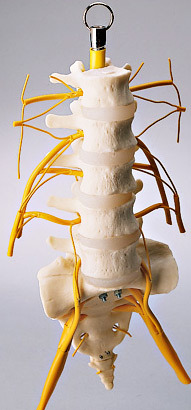 Osteochondrosis of lumbosacral spine is diagnosed more often than cervical or thoracic. This is explained by the fact that it is on this area of the spinal column that the main load is associated with maintaining a certain posture, walking or physical work.
Osteochondrosis of lumbosacral spine is diagnosed more often than cervical or thoracic. This is explained by the fact that it is on this area of the spinal column that the main load is associated with maintaining a certain posture, walking or physical work.
The lumbar region, like the sacral one, consists of 5 vertebrae. But in the sacrum, the vertebrae are immobile in the sacrum, which is an integral part of the pelvis. In this case, the sacrum is never subjected to osteochondrosis in isolation, its segments are involved in the inflammatory process again, after the intervertebral discs of the waist begin to suffer. Why is this happening?
As you know, each vertebra corresponds to a certain segment, consisting of a portion of the spinal cord with the nerve endings that leave it. In this case, the loin experiences the maximum possible static or dynamic load, supporting the body while walking and ensuring coordination of movements. Therefore, the cartilaginous tissue of the intervertebral disc of the lumbar spine wears out faster than the rest.
The most vulnerable points are 4 and 5 vertebrae, which, after losing elasticity, are easily shifted to the side during physical work or sudden movements. As a result of the destruction of the cartilaginous tissue, the bodies of the vertebrae squeeze each other and provoke infringement and inflammation of the roots of the spinal nerves. In the place of friction of the vertebrae, bone growths( spondylosis) are formed, and soon the inflammatory process also seizes the vertebrae of the sacral region.
In this case, osteochondrosis of the sacrum can be difficult to identify, because its manifestations are somewhat different from the symptoms of lumbar osteochondrosis. The main manifestation of problems with the lower back is pain, whereas the pain syndrome with lesions of the sacrum is supplemented by frequent urination, the appearance of an inflammatory process in the genitourinary system and rectum. In this case, patients find it difficult to specify the exact location of pain syndrome localization.
Symptoms and stages of osteochondrosis
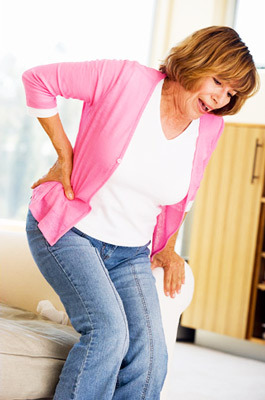
The main signs of osteochondrosis of the lumbosacral spine are stupid, aching pains at the bottom of the back. With prolonged exposure in an uncomfortable position, the pain intensifies and subsides when the patient assumes a prone position. With the progression of osteochondrosis, the following general symptoms are noted:
- Strong, severe pain during physical exertion, sharp bends or after hypothermia.
- Shoots giving in the limbs and coccyx.
- Muscle tension in the lower back.
- Frequent urge to urinate.
- Weakness and numbness of the lower limbs.
- Limitation of mobility, curvature of the spinal column( scoliosis).
- Lameness that appears when the nerve root is squeezed.
Osteochondrosis in this department develops gradually, in accordance with the characteristic symptoms, specialists distinguish in intervertebral osteochondrosis of the lumbosacral spine of Stage 4:
At , the first stage, patients complain of a tingling sensation and a burning sensation in the lower back and dull back pain,which increase after physical exertion or sudden movements. At rest, the pain syndrome fades. Thus, initial changes in the intervertebral discs manifest themselves.

On the , the second stage, the distance between the vertebrae is reduced by the gradual destruction of the fibrous ring. During this period, the symptoms become more vivid. At times, there are sharp pains, giving to the buttock, thigh and shin on the side of the lesion. A strong pain syndrome develops when the nerve endings are jammed. In this case, the patient freezes in the posture in which he was seized by an attack, he is not able to move or straighten up because of intense pain.
Similar lumbar pains in osteochondrosis are called lumbago( lumbago), during an attack the patient may additionally feel cold or burning sensation on the skin. Often, at the time of the attack, there is a feeling of chills( paresthesia) and a profuse sweat secretion. At this stage protrusions of the discs develop, which are accompanied by their stretching or protrusion beyond the vertebrae. In this case, attacks of lumbago can continue for a week, and each subsequent can last longer than the previous one.
In chronic lumbargia, the symptoms of osteochondrosis are less pronounced, the pains are less intense, they increase after a long time in one position or physical activity. At the same time, the intervals between attacks are getting shorter every day.
At the of the third stage, the fibrous rings collapse completely, which leads to the formation of intervertebral hernias and significant degeneration of the spinal column segments in the lumbar region. At this stage, the spine deforms, the pains become much stronger and are permanent. 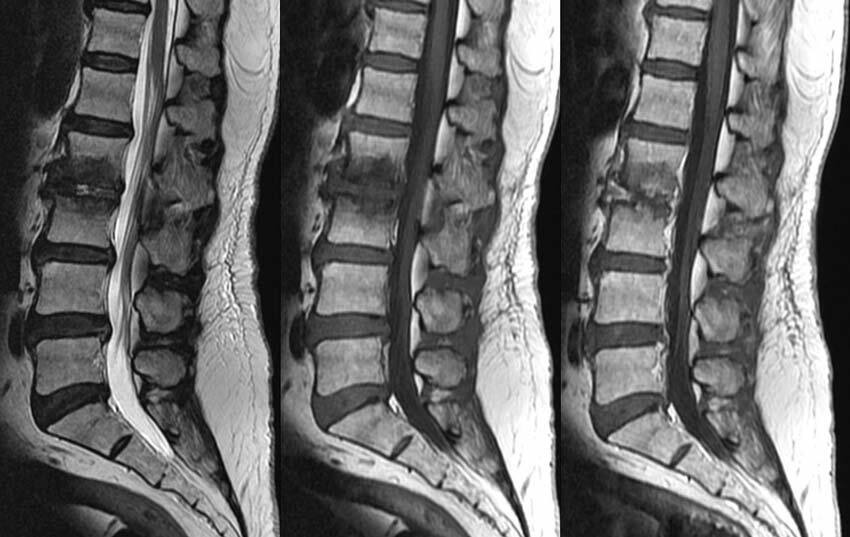
In the last, fourth stage, the spine is severely deformed, which hinders the movement of the patient and leads to disability. There is a pathological proliferation of vertebrae in the lumbar region, which ends in a loss of flexibility and mobility of the spine. The pains may subside for a short while, which is indicative not of an improvement in the condition, but of a further proliferation of bone tissue.
In the diagnosis of osteochondrosis the leading feature will be mobility impairment. And with an attempt to turn or tilt, the pain intensifies and irradiates in the foot to the heel itself, causing a sensation similar to an electric shock. In the future, the symptoms of osteochondrosis are associated with muscle weakness, dryness and pallor of the skin, marked sweating. In severe osteochondrosis, there is a violation of urination and sexual dysfunction.
Osteochondrosis spondylosis of the lumbosacral spine is the most complex and painful complication in which the pathological process of deformation and destruction of the vertebrae is accompanied by the proliferation of bone tissue. Such outgrowths are called osteophytes, they look like thorns and are a kind of compensatory reaction of the organism in response to deformation of the spine. The growth of such outgrowths prevents the prolapse and displacement of the vertebrae, but leads to impaired mobility of the spinal column.
Methods of treatment
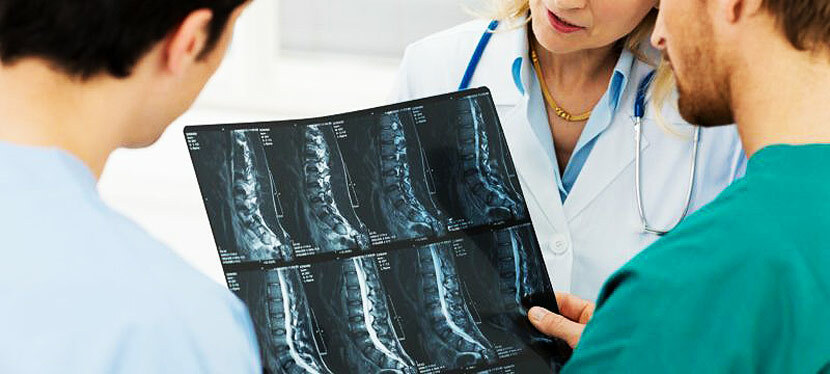 Treatment of osteochondrosis can be both conservative and surgical. Operative intervention is required for the patient already at the third stage of the pathological process. Conservative treatment includes the following activities:
Treatment of osteochondrosis can be both conservative and surgical. Operative intervention is required for the patient already at the third stage of the pathological process. Conservative treatment includes the following activities:
- Drug treatment
- Physiotherapy
- Manual therapy, therapeutic gymnastics
- Folk remedies
Drug therapy includes the following:
- Analgesics( renalgine, dexalgin, analgin with diphenhydramine).Analgesics nyxes from the osteochondrosis of the lumbosacral spine can relieve pain and tension and improve the patient's condition.
- Anti-inflammatory drugs( NVS) are used to eliminate pain and inflammation. For this purpose, appoint diclofenac, ketonal, indomethacin, ketoprofen( in tablets and injections).
- Injections of corticosteroids( methylprednisolone, hydrocortisone) are performed in the intervertebral area to relieve attacks of acute pain.
- Medications - muscle relaxants are prescribed to eliminate muscle spasms.
-
 Chondroprotectors( chondroitin, glucosamine) are used to restore cartilaginous tissue in intervertebral discs.
Chondroprotectors( chondroitin, glucosamine) are used to restore cartilaginous tissue in intervertebral discs. - Complexes containing B vitamins. Such agents help restore metabolic processes, remove excess fluid from the body and help reduce inflammation.
- Novokainovye blockades are used for local anesthesia in severe disease during stages 3 and 4.
- Drugs that improve blood circulation( trental, pentoxifylline) are administered intravenously.
- Immunomodulators( pentoxil, thymogen) are prescribed to enhance the body's defenses and strengthen immunity.
Physiotherapy
Medical treatment is complemented by physiotherapeutic procedures that help to eliminate muscle spasms, relieve pain and accelerate metabolic and recovery processes. The most popular procedures are:
-
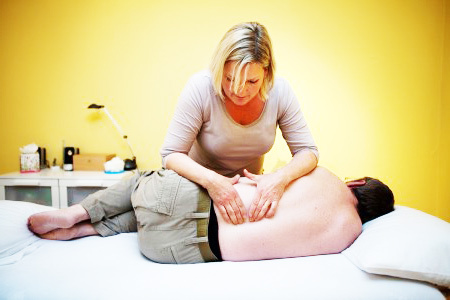 Darsonvalization
Darsonvalization - Amplipulse
- Phonophoresis
- Diadynamic currents
- Laser therapy
- Magnetic resonance therapy
Physiotherapy
The goal of exercise therapy is to strengthen the muscles of the back, relax, and remove pain. The complex of exercises, which the doctor will select individually, should be performed during the remission of the disease. Here are a few common exercises:
- Feet on shoulder width, fists rest on lower back. Knees slightly flex and flex in such a way as to feel the tension of the muscles in the waist, abdomen and knees. In this position, hold the breath for 15 seconds. Exercise is repeated 5 to 10 times. It is believed that it helps to relieve spasms and relax the supporting muscles of the spine.
- Lie on your back, on a hard surface and carry out your feet with movements called "horizontal and vertical scissors", then twist the "bike".Such exercises will help to remove the irritation of the nerve roots.
A good effect is given by exercises aimed at stretching the spine along its axis, which allows increasing the distance between the discs and ensuring the decompression of nerve endings.
During the remission period, the patient can be assigned to wear a corset, therapeutic massages and manual therapy sessions, which must be performed by an experienced specialist.
Traditional medicine
 Folk remedies can be used at any stage of the disease, time-tested recipes can help reduce inflammation and relieve pain.
Folk remedies can be used at any stage of the disease, time-tested recipes can help reduce inflammation and relieve pain.
- Household soap( 100 g) is rubbed, a lot of pour 200ml of vegetable oil, add 1 small spoon of soda and 2 tablespoons of sea salt. The composition is mixed, left in a warm place for 3 days, after which the patient is used for rubbing the diseased waist.
- Homemade ointment is prepared on the basis of the horse chestnut fruit( 3pcs), which is ground and combined with 1 tsp.camphor alcohol and 100 g of pork fat. Ointment is used for daily rubbing into the affected area.
Reviews for the treatment of osteochondrosis of the lumbosacral spine
Reviews say that the sooner the treatment is started, the better the chances of recovery.
I have suffered from osteochondrosis for a long time, I am suffering from pain in the lower back, when the disease is aggravated there are lumbago, when it is impossible to straighten up from the severe pain. During exacerbations I am kept on pricks, the doctor writes out strong anesthetizing and anti-inflammatory preparations and a bunch of different medicines. But the disease is progressing, and every autumn there are exacerbations.
Kira, Almetyevsk
In the past to year have diagnosed an osteochondrosis. From illness the waist suffers, it is necessary to make sharp movement or to work physically, as the pain does not allow to be straightened. I recently underwent treatment in a hospital, now I feel much better, but I always have strong pain relievers on hand that help to relieve seizures.
Alexey, Tambov
Recently I began to notice the pulling pains in the lower back, the constant urge to urinate, I turned to the gynecologist, but the examination did not reveal any serious problems. But the x-ray of the spine showed that I have osteochondrosis. It turns out that when the vertebrae are affected in the region of the waist and sacrum, there may be symptoms like mine. Now I go through a course of treatment, I take a bunch of different drugs. The doctor prescribed chondroprotectors, I hope they will help stop the disease.
Oksana, Voronezh

